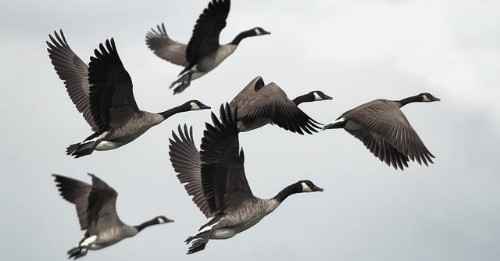Like the Wild Geese

By Wendy Saunders, guest contributor
“Whoever you are, no matter how lonely,
the world offers itself to your imagination,
calls to you like the wild geese, harsh and exciting-
over and over announcing your place
in the family of things.”
–Excerpt of “Wild Geese” by Mary Oliver
It can feel rather lonely sometimes when leading mindfulness programs or endeavoring to gather the support needed to start, sustain, or expand these programs in the workplace. This has been my experience at points during the last few years, and I’m grateful to know now that I’m not alone. Attending Mindful Leader and the Garrison Institute’s “Creating a Culture of Mindfulness at Work” un-conference last month helped me see that others have been (or are currently) going through similar experiences—and that I have a place in the workplace mindfulness and compassion “family of things.” I’ve found a flock! (For a summary report that includes the first community-generated open source insights for mindfulness champions, click here.)
As Senior Manager of Leadership Development for YMCA of the USA, I’ve been gradually integrating mindfulness and compassion research and practice into executive and leadership development programs for YMCA leaders across the country and offering workshops on these topics for YMCA of the USA staff through our human resources department. Though I’m very grateful for the internal support I’ve received and the progress made, introducing these concepts and garnering interest has certainly required much time, energy, and persistence. This un-conference at the Garrison Institute gave me a much-needed lift—engaging with 37 other professionals who are also working to integrate these concepts into their work environments led me to imagine many more possibilities in my work and reinvigorated me to keep flying ahead.
In particular, I found it incredibly inspiring to learn that reputable companies with hundreds of employees have invested in senior-level positions like “Chief Mindfulness Officer,” “Head of People Operations & Mindfulness,” and “Director of Mindfulness.” I was captivated hearing how people were shifting company cultures with the help of artifacts, like name plaques on desks that just read, “be here now,” and specially-branded mindfulness stickers for their employees’ phones. I left intrigued by companies negotiating contracts to offer apps like Headspace free to all their staff, and by the thoughtful strategies companies are using to demonstrate the effectiveness of mindfulness programs to key decision-makers.
Equally inspiring was hearing the stories of CEOs, educators at all levels, and other business and organizational leaders who are in the early stages of creating programs or seeking ways to broaden and/or deepen their efforts. I found myself contemplating questions like, “What more can I do to shift our work culture to a more mindful one, beyond particular leadership development and self-care offerings?,” “How can mindfulness be integrated into our change management practices?” and “What metrics can I utilize to show the success and impact of these programs and build a strong case for expanding them?”. Just last week, as a result of this retreat, following a workshop I led on mindfulness and self-compassion with a group of nearly 100 YMCA leaders, I launched my first brief follow-up survey to begin this critical data-collection process.
In the past year or so, I’ve been receiving a growing number of requests from Y leaders across the country for a standardized and YMCA-branded curriculum they can use to introduce mindfulness with their teams, and I looked to my fellow retreatants for insights. Rich discussions took place about how to scale offerings effectively and still maintain high quality and fidelity, identify internal champions across the organization, and establish a set of minimum qualifications for those who will share a program or curriculum with others. I also felt humbled to have leaders who have been in this space for years turn to me to help them deepen their understanding of how mindfulness and compassion intersect and to learn about my experiences developing and leading sessions on compassion in the workplace. It was heartening to know that all of the geese in this flock are approaching our work with curiosity and openness—and have a willingness to both lend and receive new perspectives.
One evening, we engaged in a fun activity where everyone who felt a particular statement shared aloud by a fellow participant was true for them came together in the middle of the room. One statement especially stood out for me: “I am seeking to better understand my whiteness.” A good portion of the white people in the room came together in that moment, and the conversation continued the following day as the entire group discussed the lack of racial diversity in the pool of mindfulness teachers in this country, the importance of raising awareness of one’s own biases and racial conditioning, and the potential for mindfulness practices to help decrease biases that affect decision-making in the workplace. (Interested in learning more? You might check out this HBR article and this compelling TED Talk, “The Danger of a Single Story”, by Chimamanda Ngozi Adichie.)
An unexpected yet pleasant surprise, I also learned things I never knew about wild geese at this retreat! I discovered that they rotate leaders in and out of the headwinds while flying to give each leader time to rest, and that some stay behind with members of the group who are struggling to provide extra care and attention. We all need this kind of support on our journeys from time to time, don’t we? May everyone working to create a culture of mindfulness at work know that you, too, are in the mindfulness and compassion “family of things”—and you have the support of the flock!
Wendy Saunders is Senior Manager of Leadership Development for YMCA of the USA. She is also a Certified Teacher in CBCT® (Cognitively-Based Compassion Training), a program of Emory University, and lives in Los Angeles.
To receive more resources such as this article, please sign up for our Transformational Leadership Update by clicking here.

0 comments
Leave a comment